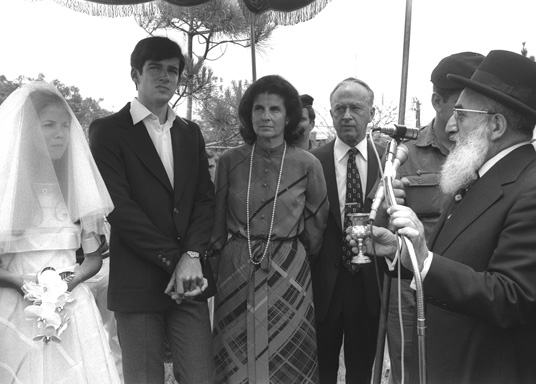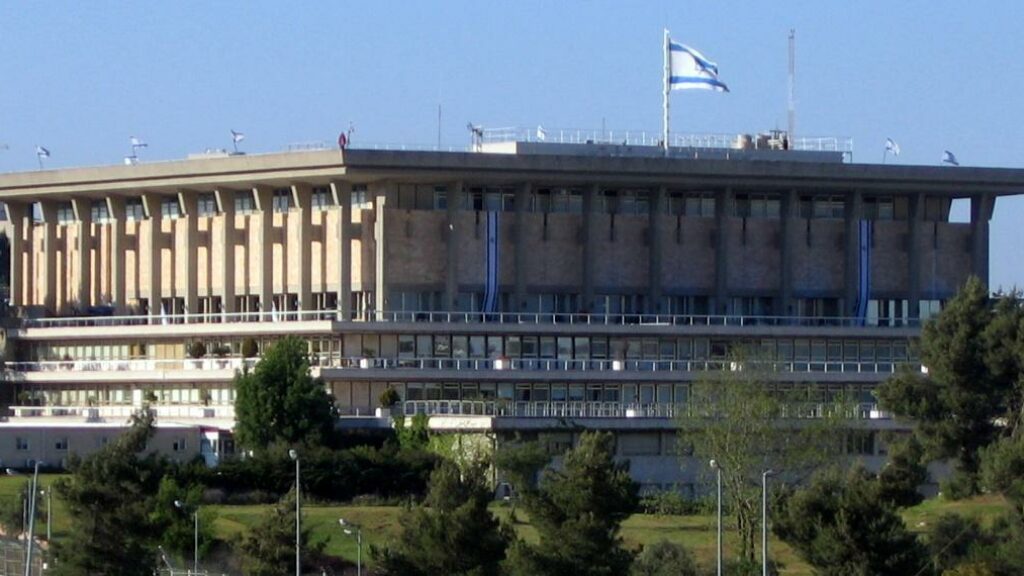Why I Defy the Israeli Chief Rabbinate
I am still not really sure how Israel’s Channel 2 got to me last summer. A reporter told me that they had received my name from a civil rights organization called Israel Hofsheet (Be Free Israel). I have nothing to do with the group, so they were probably thinking of the other rabbi interviewed in the segment, Charles Davidson, who is now listed on Israel Hofsheet’s website. However, like Rabbi Davidson, and perhaps a handful of other Israeli rabbis, I have married couples who have not registered with the Israeli Chief Rabbinate (Rabbanut). I am willing to do so despite the fact that, according to a law passed in 2013, anyone who marries in a halakhic ceremony must make efforts to register the marriage. Although there are some apparent ambiguities in its formulation and, so far, no one has been arrested let alone tried under the law, it carries penalties of up to two years in prison for any couple or rabbi convicted of violating it.
The first non-Rabbanut wedding at which I officiated was for a couple who wanted to marry under a chuppah and with kiddushin (halakhic betrothal), “in accordance with the law of Moses and Israel.” However, their feelings about the Rabbanut were so profoundly negative that they did not want it to have any role in their wedding. One way for American readers to begin to appreciate this sentiment is to imagine asking an official from the Bureau of Motor Vehicles to officiate at their wedding, though, as the journalists at Channel 2 and others have shown, it’s really much worse than that.
The second wedding was for an Ethiopian couple. The groom, frustrated that the Rabbanut conversion court seemed to be in no hurry to convert him, converted with a private rabbinic court and then came to me. Of course, I haven’t married every couple that has come to me for a non-Rabbanut wedding. In the first place, I perform only halakhic weddings. I also insist upon a prenuptial agreement requiring a get (halakhic divorce) in the event that the marriage is dissolved. Finally, I insist that the couple have a civil marriage somewhere (usually they go to Cyprus, along with all of the other Israelis avoiding the Rabbanut).
After the Channel 2 story aired, even Tzohar, the religious Zionist rabbinic group whose aim is to reform the Rabbanut, condemned the “maverick rabbis” who perform unauthorized weddings. A week later, a coalition of religious Zionist rabbis, led by Tzohar’s chairman, Rabbi David Stav, and the distinguished octogenarian Rabbi Nahum Rabinovitch, announced that they had begun converting people to Judaism outside the auspices of the Rabbanut. This wasn’t illegal—there is no Israeli law that grants the Rabbanut the sole power to create conversion panels—but it was still a challenge to the Rabbanut’s authority. Unless the Rabbanut recognizes the validity of these new conversion panels, the converts cannot have a Jewish wedding in Israel—or, at least, not a legal one.

Although the Rabbanut conversion process is often capricious, needlessly adversarial, and hopelessly bureaucratic, the main motivation for the new courts was the historical failure of the Rabbanut to come up with a viable, welcoming policy with regard to immigrants of Jewish ancestry from the former Soviet Union. In a statement, Rabbis Stav and Rabinovitch spoke of the “moral responsibility . . . to attend to the absorption of immigrants and their full integration.” Setting aside the question of whether religious conversion ought to be a part of a modern democracy’s immigration policy, this move was something of a last resort, coming only after attempts to loosen the Rabbanut’s grip on conversion through legislation, regulation, litigation, and a multimillion-dollar campaign to get Stav elected chief rabbi had all failed.
Reactions to these challenges to the Rabbanut’s authority have not been mild. In a weekly column, Rabbi Shlomo Aviner, an influential religious Zionist, wrote that anyone who works against the Rabbanut has the status of a “rodef,” literally a “pursuer,” or attacker, whose life can be taken to save the pursued. Even those Israelis not well-versed in rabbinic literature remember that Yigal Amir justified his assassination of Yitzhak Rabin in precisely these terms. Of course, as he subsequently explained, Rabbi Aviner did not really mean to be taken literally, but his overheated rhetoric suggests that the Rabbanut and the ideology that ascribes theological and even messianic significance to a government bureaucracy are in trouble.
In short, the Rabbanut and its supporters condemn Rabbi Stav for subverting its power over conversion, and Rabbi Stav’s organization condemns me for subverting the Rabbanut’s power over marriage, even though their converts can wed in Israel only outside the Rabbanut. The paradox of rabbis who simultaneously undermine and reinforce the Rabbanut derives from their belief that the Israeli Chief Rabbinate is necessary to protect the integrity of the Jewish people, but that it is presently failing at the task. Even the new conversion initiative is meant to promote, or provoke, change from within the Rabbanut.
One way to illustrate this paradox is by looking a little more closely at the law that provides for up to two years in prison for anyone who dares to avoid the Rabbanut, no matter how faithfully they follow the rabbinic laws of marriage. This law actually began as an attempt at moderate reform from within, along the general lines of American “school choice” initiatives. It allows couples to register and marry through any local office of the Rabbanut instead of limiting them to the jurisdiction of the office in the bride or groom’s place of residence. Thus, the law gives couples greater flexibility to choose a rabbi, but, at the same time, it cements the Rabbanut’s total control of Jewish marriage in Israel and criminalizes dissent. This law is generally known as the “Tzohar law,” after the name of its principal sponsor.
The problem with the Rabbanut and the related Ministry of Religious Services is not that they have deviated from their historical mission and are now malfunctioning. By design, the Rabbanut reduces rabbis to bureaucrats. As a government agency like any other, it is subject to partisan wrangling and the temptations of patronage and corruption. Worse, the Rabbanut is particularly ill-suited to functioning as a government bureaucracy. A historical institution—the rabbinate—that traditionally functioned on the basis of collegial trust, the flexibility to address unique circumstances, and tolerance of local differences is ill-suited to becoming a rigid, regulated, centralized, and bureaucratic regime. Forcing it to do so has made it monstrous. Moreover, the price of authority over a very limited social sphere has been irrelevance in all other spheres of Israeli religious and cultural life. This trade-off was noted by the late Jewish philosopher Yeshayahu Leibowitz as early as 1959:
[N]othing weakens the strength and influence and persuasiveness of religion and prevents the winning of hearts more than religious institutions which are kept by a secular state, more than investing secular functions with an official religious aura, than religious laws included like aberrations in a code of secular legislation.
A second problem with the centralization of Jewish religious authority is that it weakened local communities as a basic unit of religious life. This was no accident. During the state’s early years, David Ben-Gurion, Israel’s first prime minister, chose to retain the Ottoman-era ecclesiastical courts that governed personal status within religious communities, both as a concession to religious factions and as a key element of his state-building effort.

As political scientist Yüksel Sezgin has argued convincingly, Ben-Gurion deemed it important to create a new Jewish-Israeli identity that would supersede the manifold ethnic and religious identities forged over the centuries in the Jewish diaspora. Israel could have recognized multiple Jewish communities, as Israel recognized and empowered the clergy of 11 faith communities (Jewish, Sunni Muslim, and nine Christian churches) and even added three more (Baha’i, Druze, and an additional Christian church). However, Ben-Gurion understood that a central religious body monitoring the boundaries of the Jewish people would reinforce state consciousness, whereas decentralized Jewish communities would compete with the state and with each other for citizens’ allegiances and resources.
The upshot is that, with the important exception of Ashkenazi haredim, generations of Israelis have come to expect the state to provide them with rabbis, synagogues, ritual baths, and a host of other services and institutions that were traditionally provided by local communities. By the same token, the state-appointed staffs of these establishments are not regarded as communal leaders but as mere functionaries.
The most common refrain among critics of the Rabbanut is that it is overly stringent, increasingly extremist, and dominated by haredim, who have no religious stake in the integrity of the institution or, indeed, of the Zionist project. This is a radical misunderstanding of the problem, which is structural: a matter of political philosophy not personnel.
The Rabbanut uses state power to impose uniformity, which in turn forces religious groups to compete for control of the state religious apparatus. This was less apparent in the first 25 years of Israel’s statehood when the Rabbanut was headed by consensus-building figures, such as Rabbis Yitzhak Herzog and Ben-Zion Meir Hai Uziel, and the haredi world was politically weak. However, the potential to transform the Rabbanut into a winner-take-all contest was always present. It first became a reality not under a haredi chief rabbi who was beholden to overly strict, anti-Zionist roshei yeshiva, but under religious Zionist hero Rabbi Shlomo Goren. Goren had been on the scene during the capture of the Old City of Jerusalem in the Six-Day War and famously led the first minyan at the newly liberated Western Wall. Rabbi Goren understood, like many others, that Jewish law was presently unfit to serve as the law of a modern state, but he also believed that it could be refashioned in order to do so. Having concluded that halakha could, in principle, function as state law, he was also willing to enforce it by means of state power.

In 1972, politicians enamored with his willingness to make halakha conform to the logic of the state deposed the incumbent chief rabbi and elected Rabbi Goren. This was in the midst of the famous controversy over Hanokh and Miriam Langer, two young soldiers whose mother had not obtained a halakhic divorce from her previous husband before marrying their father. This seemed to render the Langers mamzerim (literally, bastards), who had been born of an adulterous union, and were thus forbidden to marry Jews. Despite the rabbinic tradition of finding every leniency to prevent such situations, a rabbinical court consisting of Rabbis Yosef Shalom Elyashiv, Ovadia Yosef, and Shaul Yisraeli—leading rabbinic figures in the haredi, Sephardi, and religious Zionist camps respectively—held that this was indeed the case. Following a public outcry, Defense Minister Moshe Dayan threatened to institute civil marriage if a halakhic solution was not found, and one Knesset faction even proposed such a law, precipitating a coalition crisis. Enter new Chief Rabbi Goren, who overruled the rabbinic court, arguing that the mother’s first husband, a convert, had never really been Jewish because there were ample grounds to doubt that he had been properly converted in Poland. For this and other reasons (the facts of the case were quite messy), Goren cast doubt on the validity of the first marriage.
The Langer case ought to have been a great success for Rabbi Goren. He had successfully freed a brother and sister from their unmarriageable status, while staving off political threats to limit the powers of the rabbinate. But it was also the moment when the benignly condescending haredi attitude toward the Rabbanut became one of utter contempt. When Israel effectively became a two-bloc parliamentary system in 1977, haredi parties used their newfound bargaining power to take the Rabbanut out of the hands of Rabbi Goren and the religious Zionists and make it a source of patronage jobs for their own people. More than a generation later, this remains the state of affairs. In retrospect, it looks like Moshe Dayan might have had the better solution, even—or especially—in religious terms.
Would returning the Rabbanut to the control of religious Zionists, even thoughtful, moderate ones such as the rabbis allied with Tzohar, solve the problem? Only if you think that the only problem with the Rabbanut is who is in charge of it. But even if one ignores the systemic problems resulting from the entanglement of religion and state, this approach virtually guarantees that the tug of war over control of the Rabbanut will never end. Every time a new chief rabbi is elected or a new government coalition is formed, there will be a fierce struggle for control, and every time the Rabbanut or Ministry of Religious Services changes hands, there is a risk that the new regime will attempt to unravel whatever the outgoing regime accomplished. Since no party can decisively win this contest, the only way to end it is to find a way to take away the prize.
The problems with the Rabbanut are not merely theoretical. In recent polls, 71 percent of Israeli Jews expressed dissatisfaction with the Rabbanut and about 65 percent favored its dissolution. But what does “dissolution” mean in this context? What does the growing chorus of Israelis who demand “separation” of religion and state want?
It turns out that “separation” is not exactly the right word for what Israelis want. Even if it were, it would be politically unattainable. Such a sweeping change would be opposed not only by Israel’s Orthodox parliamentarians—who constitute at least a quarter of every Knesset and who would see the view as motivated by anti-religious sentiment—but also by its Arab politicians, who don’t want their communities’ religious institutions to be disestablished. Muslim and Orthodox Jewish parliamentarians have in fact joined forces in the past to oppose legislation that would reduce the power of religious courts. Moreover, any coalition that includes neither Jewish religious parties nor Arab parties would be very unstable, making it unlikely that it would last long enough to make irreversible changes.
From a practical perspective, abolishing the Rabbanut would create an unworkable vacuum. For example, a child born to a mother who married her first husband halakhically and divorced him in a newly instituted civil procedure would be just as unmarriageable as the Langer children had been before Goren’s intervention. In contrast to disputes over “who is a Jew?”—which can often be resolved through a pro forma conversion—mamzerut is a stigma that is inherited from either parent and forbids those who bear it from marrying into the Jewish community. Although one can imagine solutions to this problem, it is also possible that fully separating Judaism and state would result, within a few generations, in two or more distinct and endogamous Jewish populations.
Other effects of abolition would be less dire. The kosher-certification industry, for instance, could, perhaps, be privatized overnight, but a religious free market would beckon all sorts of charlatans and predators before the population learned how to be informed consumers. It would take some time for Israeli Jews to relearn how to build functioning communities. Thus, if the Rabbanut is going to die, it must be a slow death.
Finally, of course, there is the fundamental impossibility of separating Judaism from the State of Israel. Even if distinguishing Israeli identity from Jewish identity would make life easier in some respects for Arabs and haredim, there is no doubt that Israel must remain the nation-state of the Jewish people, and thus there will continue to be a great deal of overlap between Israeli identity and Jewishness. It is also clear that Judaism cannot be reduced to either nationality or religion. The Jewish nation- state might attempt—and arguably has attempted, and failed—to repurpose Jewish symbols to forge a desacralized, national civic religion, but not without doing violence to the Jewish religion. The goal, therefore, must not be to separate the Jewish religion from the Jewish state but to minimize the degree to which religious institutions exercise the coercive power of the state.
There are two historical pacts that point the way to disentangling religion and state in Israel. The first may seem like a poor choice: the “Status Quo Agreement” reached by David Ben-Gurion, then chairman of The Jewish Agency Executive, and the leaders of the haredi Agudat Yisrael faction in June 1947. It was in this agreement that Ben-Gurion agreed that marriage and divorce in the future Jewish state would remain under the auspices of rabbinical courts inherited from Ottoman times—ground zero for the entanglement of religion and state in Israel.
However, there were three other important features of that agreement: Jewish religious communities would have educational autonomy as long as certain basic curricular requirements were met, Shabbat would be the national day of rest, and public institutions would serve kosher food. Educational autonomy protects the freedom of individuals and communities to practice their religion and raise their children in accord with their values. Recognizing Shabbat and providing only kosher food nurture non-coercive expressions of Judaism in the public sphere. Taken together, these arrangements strengthen the state’s commitment to civil liberties while simultaneously strengthening its Jewish character. In the context of any new grand bargain, they suggest that the operative guideline should be the minimization of religious coercion while allowing and even fostering non-coercive expressions of the Jewish religion and vigilantly protecting religion’s free exercise.
The second pact was never put into practice. In 2004 Rabbi Yaacov Medan, a leading religious Zionist rabbi (and a prime mover behind the new conversion initiative), and Professor Ruth Gavison, a distinguished and avowedly nonreligious member of The Hebrew University’s Faculty of Law, published an extraordinary document known as the “Gavison-Medan Covenant.” It offered concrete proposals for privatizing and regulating kosher certification, implementing a civil marriage regime that attempts to take religious strictures and differences into account, and recognizing conversions performed in Israel and abroad by panels of any Jewish denomination. Throughout the document, Gavison and Medan posit national unity as the primary goal without attempting to police the borders of the Jewish people in the way that the Rabbanut now does.
The Gavison-Medan Covenant has some shortcomings. For one thing, it outlines what the law ought to be but provides no road map for getting there or even somewhere reasonably close. Another problem is that it appeals to values that are not shared by haredim (or Arabs, though that is a separate discussion). It seeks a set of mutually agreeable ground rules by which religious and secular Zionists can coexist, but does not recognize the need for any lasting social compromise to reach further. Finally, some of the key compromises of the Gavison-Medan Covenant might be unworkable today. For instance, the covenant explicitly restricts marriage to one man and one woman and retains Rabbanut control over divorce. It is hard to envision broad Israeli political support for either of those measures today, though other compromises are possible. Nonetheless, in its understanding that the Rabbanut must be disempowered and its commitment to national unity, the Gavison-Medan Covenant remains the foundation for any good proposal about the future of religion and state in Israel.
Rather than outline what I think a Gavison-Medan 2.0 might look like—after all it must be the result of prolonged political and religious discussion and compromise—let me instead briefly suggest why such a grand compromise which at least partially disempowers the Rabbanut is theologically defensible, even desirable.
Isaiah’s prophecy “I will restore your judges as of old, and your counselors as of yore . . . Zion shall be redeemed through law” (Isaiah 1:26-27) is paraphrased in the Amidah and repeated by observant Jews three times a day. It was traditionally believed that the return to Zion would include the restoration of halakha. For the first secular Zionists and their modern-day descendants this was part of the unrealistic exilic mindset for which Jewish sovereignty was the cure. Haredim, of course, believe in the eternal validity of halakha, but they are not, to say the least, committed to viewing the State of Israel as beginning the restoration of our “judges as of old.” Neither party has an ideological stake in the future of the Rabbanut. The problem, however, is acute for religious Zionists, who strive to maintain fealty to halakha while viewing the non-halakhic State of Israel as the vehicle of God’s redemption. To disempower the Rabbanut would seem to be an admission not only that the most religious of the state’s institutions has failed, but that halakha itself is incapable of serving as the law of the Jewish state. Is there a way out of this dilemma? I think that there is.
In a very suggestive passage the Talmud (Avoda Zara 8b) describes the self-imposed exile of the Sanhedrin, the halakhic supreme court:
Forty years before the destruction of the Temple, the Sanhedrin went into exile and sat in a shop . . . When they saw that murderers were proliferating and they could not judge them, they said: “It is best that we exile ourselves from place to place so that none are condemned [to death].”
The court is described here as going into self-imposed exile in order to recuse itself from judging capital cases. Presiding over an increasingly violent society, the rabbis recognized that biblical justice wasn’t working. They voluntarily relinquished power, even as the Temple still stood, to avoid implementing a halakhic regime that was ineffective.
What this passage—and it is by no means uncharacteristic of rabbinic thought—suggests is that there are traditional models for combining Jewish sovereignty with (relative) rabbinic powerlessness. My own willingness to conduct marriages outside the authority of the Rabbanut is, in part, a gesture in this direction, a recognition that halakha cannot govern the reconstituted Jewish state and, far worse, that the state is actually undermining the integrity of halakha. Israeli society may change in unforeseen ways, and halakha will surely continue to evolve. Perhaps one day it will be ready to emerge from its “exile.” But until then, halakha is better off giving up even the little state power that it has.
I am not so naïve as to think that anyone in Israel today will voluntarily give up power, but the present arrangements are not only dysfunctional, they are ultimately untenable. One way or another, the Rabbanut must be made to gradually divest itself of its power. The effect of this disempowerment will be that the eternal struggle for the soul of Judaism is not played out in the corridors of state power, but where it belongs: in homes, communities, classrooms, rabbinical schools, universities, synagogues, and the public square.
Comments
You must log in to comment Log In
Suggested Reading
No Joke
Sigmund Freud loved Jewish jokes and for many years collected material for the study that would appear in 1905 as Jokes and Their Relation to the Unconscious. An excerpt from Ruth Wisse's new book No Joke: Making Jewish Humor.

Mysterious Mishnah
According to a midrash, God will tell the contending nations: “He who possesses my mystery—he is my son.” And when they ask “What is your mystery?” God will reply, “It is the Mishnah.” How do you translate a mystery?

Method to Our Madness: A Response to Hillel Halkin
Hillel Halkin is the reason I moved to Israel. I read his Letters to an American Jewish Friend at sixteen, and my life trajectory was changed forever—mine and that of…
Joseph Roth: Grieving for a Lost Empire
Always in flight, one of the world’s permanent transients, Joseph Roth (1894–1939) was a one-man diaspora. A drunk and a fantasist, he was also a marvelous writer whose work was bedizened with metaphor, laced with simile.
Avi Keslinger
All government bodies, including law enforcement, judiciary, etc. have bureaucratic and political issues. However, one does not throw out the baby with the bath water and eliminate the state.
An Israel without rabbinic power is an Israel that is not a Jewish state. The Law of Return, for example, requires that someone decide who is Jewish - and this is so fundamental to the Jewish future that it cannot be left up to politicians. Having said that, the rabbanut could become a regulatory agency and license rabbinic courts, kashrut agencies, etc. However, the way to bring about reform is by working within the system. This, according to Megillat Taanit, is what Shimon ben Shatach did when the Sadduccees took over the Sanhedrin.